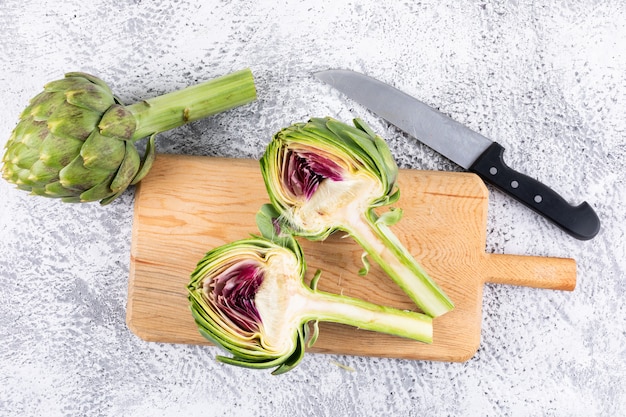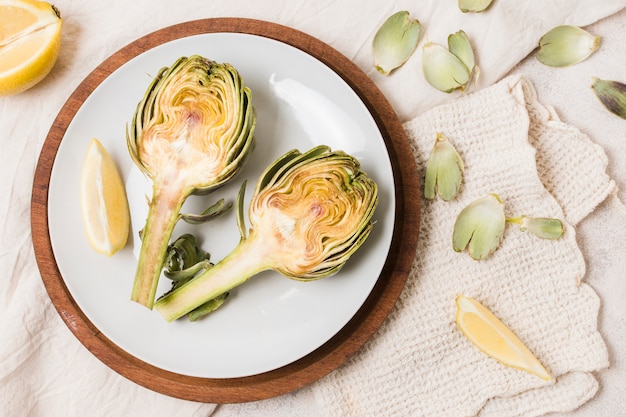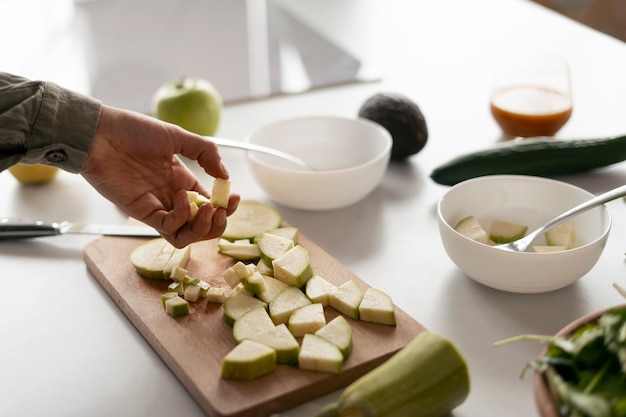Artichokes. Those spiky, green globes that seem to hold a certain mystique in the world of food. For years, they’ve been both a source of intrigue and a bit of a culinary puzzle for many. But let me tell you, once you get past the initial intimidation, you'll find they are a real treat.
I can still remember my first artichoke experience – probably around five years old. I was captivated by its unique look, a bit confused, but definitely intrigued. My mum, ever patient, showed me how to navigate the prickly leaves, and that was it - I was hooked. Ever since, I’ve been on a quest to explore all things artichoke, from simple preparations to more adventurous recipes. And let me tell you, there's nothing quite like a perfectly cooked artichoke – it’s a symphony of flavors and textures that is hard to resist.
(Part 1) The Art of Choosing the Perfect Artichoke

Imagine buying a banana that's bruised and brown – you wouldn’t want to eat it, would you? Well, the same goes for artichokes. Selecting the right ones is essential to enjoying their true potential. Here’s how you can make sure you’re getting the best artichokes at the market.
1. Look for Freshness: The Tell-Tale Signs
It's all about that first impression. Grab an artichoke, give it a good sniff, and let your nose be your guide. A fresh artichoke should have a sweet, slightly grassy scent, a bit like a meadow on a warm summer day. If you detect even a hint of something off, it’s best to pass.
Next, check those leaves. They should be tightly packed, almost like a closed fist, and feel firm to the touch. Avoid any artichokes with loose or limp leaves, as these are signs they’ve been around for a bit too long.
2. Size Matters: Finding the Right Fit
Not all artichokes are created equal. They come in a range of sizes, and the perfect one for you depends on what you have in mind. For a smaller, intimate dinner, a smaller artichoke will do just fine. But if you’re planning a feast, go for a larger one that can feed the whole crew. Remember, you want an artichoke that feels firm and heavy for its size – it’s a sign of plumpness and lots of deliciousness inside!
3. The Bottom Line: Inspecting the Base
Don’t forget to peek at the bottom of the artichoke, known as the “heart.” It should be firm and solid, almost like a well-formed ball. If it feels soft or mushy, it’s a sign that the artichoke has started to decline.
(Part 2) Prepping for Success: Unlocking the Artichoke’s Potential

Now that you’ve got your prize-winning artichokes, let’s get them ready for the kitchen. Prepping them properly will make cooking and eating them a breeze, trust me.
1. The Trimming Technique: Removing the Unwanted
Grab a good sharp knife – you’ll be doing a bit of trimming. First, cut off the top third of the artichoke, including those pointy, tough leaves. This is the part that's often bitter and doesn't contribute much to the flavor. Next, trim the base of the artichoke by cutting off about an inch or so. This is where the artichoke attaches to the stem, and it's usually quite hard and inedible.
2. Dealing with the Spikes: A Little TLC
Now for the fiddly part. Those pointy tips on the remaining leaves – we need to get rid of them. You can use a pair of kitchen shears, or a sharp knife, to snip them off. You don’t need to be super precise – just remove the sharpest parts. This will make the artichoke easier to handle and much less likely to poke your fingers.
3. The Lemon Treatment: Preventing Browning and Preserving Freshness
After trimming your artichoke, rub the cut surface with a slice of lemon. This simple trick helps prevent the artichoke from browning and keeps it looking fresh. It also adds a subtle hint of citrusy aroma, which only enhances the overall flavor.
(Part 3) Classic Cooking Methods: Unlocking the Artichoke’s Flavors

Now for the fun part – cooking! Artichokes can be cooked in a variety of ways, each one showcasing a unique side of their flavor profile. Let's dive into some classic methods.
1. Steaming: The Simple Approach for Subtle Flavor
Steaming is a great way to cook artichokes because it preserves their natural flavor and tenderness. It's a gentle approach that allows the artichoke's inherent taste to shine. Fill a large pot with about an inch of water, add a tablespoon of lemon juice to the water, and bring it to a boil. Place a steamer basket over the boiling water, add your prepared artichokes, and cover the pot. Steam for about 45 minutes, or until the artichokes are tender. You’ll know they’re ready when the outer leaves pull away easily.
2. Boiling: A Quick and Easy Method for Everyday
Boiling is a straightforward and efficient method for cooking artichokes. It’s a good go-to when you need a quick and easy meal. Fill a large pot with salted water and bring it to a boil. Add the artichokes and reduce the heat to a simmer. Cook for about 30-40 minutes, or until the artichokes are tender. Again, you'll know they're done when the leaves pull away easily.
3. Roasting: Bringing Out the Sweetness and Creating a Caramelized Crust
Roasting artichokes is a delicious way to enhance their natural sweetness and create a lovely caramelized crust. Preheat your oven to 400°F (200°C). Place the artichokes in a baking dish and drizzle them with olive oil. Season with salt, pepper, and any other herbs you fancy. Roast for about 30-40 minutes, or until the artichokes are tender and golden brown. The best part? You can roast them with other vegetables like potatoes or onions for a complete meal.
4. Grilling: Adding a Smoky Delight
Grilling artichokes adds a smoky flavor and beautiful char marks, giving them a touch of rustic charm. Preheat your grill to medium heat. Brush the artichokes with olive oil and season with salt and pepper. Grill for about 20-30 minutes, turning every 10 minutes, or until the artichokes are tender and lightly charred. The char adds a smoky, almost earthy flavor to the artichokes, a real treat for those who enjoy a bit of char on their food.
(Part 4) Beyond the Basics: Creative Cooking
Now that you've got the classic cooking methods down, let's explore some creative ways to use artichokes. They are incredibly versatile and can be incorporated into a wide range of dishes, from simple salads to hearty pasta dishes.
1. Stuffed artichoke hearts: A Culinary Classic
Stuffed artichoke hearts are a real crowd-pleaser. They’re elegant enough for a special occasion, but also easy enough for a weeknight dinner. After cooking the artichoke, carefully remove the inner leaves to reveal the heart. You can stuff the heart with a variety of fillings, such as bread crumbs, herbs, cheese, or even sausage. Bake the stuffed artichoke heart until the filling is bubbly and golden brown. The flavors are just incredible! You can even make it a little fancy by topping it with breadcrumbs and Parmesan cheese for a crusty topping.
2. artichoke salad: A Refreshing Touch of Flavor and Texture
A salad is a fantastic way to showcase the fresh, slightly tart flavor of the artichoke. The simplest way to do it is to use the cooked artichoke hearts. You can marinate them in lemon juice and olive oil and add them to a mixed green salad. For a more substantial salad, chop the artichoke hearts and combine them with other ingredients like tomatoes, cucumbers, feta cheese, or olives. A light vinaigrette dressing complements the artichoke’s delicate flavor perfectly.
3. artichoke dip: The Party Starter
Who doesn’t love a good dip? Artichokes are a natural for this, and artichoke dip is a classic for good reason. You can find pre-made artichoke hearts in a jar, or use fresh, cooked hearts. Combine the hearts with cream cheese, mayonnaise, garlic, and seasonings. Bake the mixture in a small oven-safe dish until it’s bubbly and golden brown. Serve with crusty bread or crackers for an irresistible snack or appetizer.
4. Artichoke and Mushroom Risotto: A Hearty Delight
This is a dish that’s both elegant and comforting. Start with a good quality arborio rice and cook it in a flavorful vegetable broth, along with chopped artichoke hearts and mushrooms. Add some white wine for a subtle complexity. Stir in Parmesan cheese at the end for a rich, creamy texture. This dish is perfect for a special occasion or a cozy night in.
(Part 5) Eating Artichokes: The Art of the Fork
So you’ve cooked your artichoke, now it's time to tackle the eating part. Don't worry, it's not as complicated as it looks.
1. The Leaf by Leaf Approach: Savor Every Bite
Hold the artichoke base in your hand, and pick off an outer leaf. Dip the fleshy bottom of the leaf into butter, olive oil, or your favorite dipping sauce. Then, gently scrape the soft part of the leaf with your teeth. Don’t bite into the tough tip of the leaf! Keep working your way down the artichoke, leaf by leaf, savoring each bite.
2. The Heart of the Matter: A Delicate Treasure
Once you’ve reached the heart, you’ll be greeted with a tender, delicious center. It’s best to eat this with a fork. You can also use a knife to cut the heart into smaller pieces, if you prefer. The heart has a more concentrated artichoke flavor, so savor it!
3. The Choke: A Word of Caution
As you reach the center of the artichoke, you’ll come across a hairy, fuzzy part called the “choke”. This is not edible and can be quite unpleasant. If you see it, simply scrape it off with a spoon or your fingers. You can also remove it before you start eating by cutting off the top part of the heart.
(Part 6) Beyond the Ordinary: Artichokes in World Cuisine
Artichokes are a global treasure, and different cultures around the world have their own unique ways of preparing and enjoying them. They’ve been a culinary staple for centuries, and each region has developed its own special touch.
1. Roman Artichoke Hearts: A Taste of Italy
Roman artichoke hearts are a staple of Italian cuisine. They are typically cooked in olive oil and garlic, and often served as a side dish or as an ingredient in pasta sauces. The Romans also love to prepare them with pancetta and black pepper for a hearty and savory dish.
2. grilled artichokes with Lemon and Herbs: A Greek Delicacy
In Greece, artichokes are often grilled and served with a simple lemon-herb dressing. The charred flavor of the grilled artichokes pairs perfectly with the bright, citrusy notes of the lemon dressing. The Greeks also enjoy adding fresh oregano, thyme, and parsley to their dishes. The combination of char and citrus creates a truly delightful taste experience.
3. Fried Artichokes: A Spanish Tradition
Spanish cuisine often features fried artichokes. The artichokes are typically cut into wedges, dredged in flour, and then deep-fried until golden brown. They can be served as a tapas dish or as a side to seafood. The fried artichokes have a crispy exterior and a tender, flavorful interior. The contrasting textures and the deep, rich flavors make them a popular choice for a quick and satisfying bite.
(Part 7) Beyond the Plate: The Benefits of Artichokes
Did you know that artichokes aren’t just delicious? They’re packed with nutrients, too! These spiky green globes are a nutritional powerhouse, offering a range of benefits for your health and well-being.
1. A Source of Fiber and Antioxidants: Supporting Digestive Health and Fighting Free Radicals
Artichokes are a good source of dietary fiber, which is essential for digestive health. Fiber helps regulate digestion, promotes regularity, and can even help lower cholesterol levels. They also contain antioxidants, which help protect your body against damage caused by free radicals. These antioxidants have been linked to reducing the risk of certain types of cancer.
2. Supporting Liver Health: Helping Your Liver Function
The artichoke contains a compound called cynarin, which is believed to help support liver function. Cynarin may also help promote the flow of bile, which is important for digesting fats.
3. Managing Cholesterol Levels: A Potential Ally in Heart Health
Research suggests that artichoke extract may help lower cholesterol levels, particularly LDL (bad) cholesterol. However, more research is needed to confirm these findings.
(Part 8) FAQs: The Questions You’ve Been Asking
Let’s tackle some of the most common questions about artichokes. We’ve all been there, wondering about the best way to store them, whether we can freeze them, or just curious about the anatomy of these spiky wonders.
How long do artichokes last?
fresh artichokes can last for about 3-5 days in the refrigerator. Store them in a plastic bag in the crisper drawer. To extend their lifespan, you can also wrap them in newspaper. Avoid washing them before storing, as this can cause them to spoil more quickly.
What if I can’t find fresh artichokes?
Don’t worry! You can find canned or frozen artichoke hearts in most supermarkets. They are often used in salads, dips, and other dishes. Although they don’t have the same freshness as fresh artichokes, they are still a good source of flavor and nutrients.
Can I freeze artichokes?
Yes, you can freeze cooked artichokes. Simply blanch them for a few minutes in boiling water, then drain and pat them dry. You can then freeze them in a freezer bag or airtight container. Frozen artichokes can be used in soups, stews, and other dishes.
What’s the best way to store leftover artichokes?
Cooked artichokes can be stored in the refrigerator for up to 3-4 days. They should be kept in an airtight container or wrapped tightly in plastic wrap.
Are artichoke hearts really hearts?
Actually, no! The “heart” of the artichoke is actually the base of the flower bud. It's the most tender part of the artichoke and has the most concentrated artichoke flavor. Think of it as the essence of the artichoke.
There you have it! I hope this guide has demystified the world of artichokes for you and inspired you to explore their unique flavors and benefits. Remember, cooking and eating artichokes is all about embracing the experience – the spiky leaves, the messy fingers, the deliciousness. So go forth, grab an artichoke, and get cooking!
Everyone is watching

How to Cook Frozen Lobster Tails Perfectly: A Step-by-Step Guide
RecipesLobster. Just the word conjures up images of lavish meals, special occasions, and a taste of luxury. But let's...

Pigs in a Blanket Cooking Time: How Long to Bake for Perfect Results
RecipesAh, pigs in a blanket. Just the name conjures up images of those delightful little parcels of crispy pastry en...

Pork Fillet Cooking Time: How Long to Cook It Perfectly
RecipesPork fillet, or tenderloin as it's sometimes called, is a real favourite in our house. It's so versatile, and...

The Ultimate Guide to Tender, Juicy Pulled Pork
RecipesRight, let's talk pulled pork. It's one of those dishes that just screams "comfort food," doesn't it? I mean...

The Ultimate Guide to Cooking Sweet Potatoes: From Roasting to Mashing
RecipesSweet potatoes. Just the name conjures up images of warm, comforting dishes, bursts of vibrant color, and a to...
